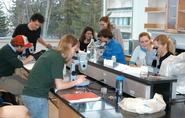
Visiting Instructor of Comparative Literature Janelle Schwartz recently brought her Comparative Literature 311 "Fields of Visibility: Science and Literature in European Romantic Thought" class to Professor of Biology Pat Reynolds' lab to look at worms through microscopes and put their theoretical knowledge of worm generation and regeneration into practice. The class is an interdisciplinary course that attracts students interested in the sciences and the humanities.
The class had just finished reading the work of eighteenth century naturalists such as Abraham Trembley and Charles Bonnet, in which they discussed the "exceptional" abilities of polyps and worms to regenerate after cutting. Until this time (about 1740), such habits of regeneration were only thought to be present in plants, and so the polyps and worms called into question the taxonomy/identification of nature's creatures. Professor Schwartz's class, with the help of Professor Reynolds, was able to perform experiments similar to those accomplished by the eighteenth century naturalists they were studying.
-- by Molly Kane '09
Posted February 3, 2006
